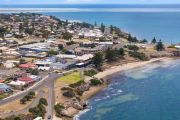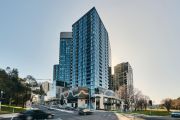
Gold Coast developers ‘right-sizing’ projects amid construction crunch
A lack of builders with the capacity to take on big jobs on Queensland’s Gold Coast is forcing developers to prioritise smaller projects, steering clear of major construction work that can turn into a long drain on profits.
MRCB International, a major Malaysian real estate group, has secured development approval for a project – a 20-storey tower with 192 apartments – on a site in Southport that limited the height and hence, the value, to $200 million, the company’s chief executive Ravi Krishnan said.

“We didn’t want to exceed 20 levels,” Krishnan said. “We wanted to be safe in the sense that we wanted to restrict our [end value] to about $200 million, so there would be a wider pool for us to be able to look for builders.”
The Maris project, on a 1743-square-metre site on Queen Street that previously housed the Sundale Motel, is the developer’s second Gold Coast project after the $500 million 26 Vista project – a 51-storey, 280-unit development in Surfers Paradise that is in final negotiations with a builder, and construction slated to start this quarter.
“There are builders available to compete and build up to 20 levels, 24 levels, as opposed to a tier one builder for a building like 26 Vista,” Krishnan said.
Challenges in finding a builder for 26 Vista were one reason MRCB decided to proceed with a smaller development this time around.
“When we purchased the Queen Street site we were mindful of the challenges of getting a builder in Queensland,” Krishnan said. “We knew that the size and scale of the Southport site would enable us to move forward quickly with that project, in terms of securing a Tier 1 builder.”
In a state grappling with a strong publicly funded infrastructure pipeline that was sucking in resources, as well as a high level of construction insolvencies, MRCB’s story was not an isolated case, said Kirsty Chessher-Brown, who runs the Urban Development Institute in the state. “We are seeing developers look at right-sizing their projects,” she said.
Three years ago, as materials and labour costs were surging to unprecedented levels as pandemic travel and transport restrictions eased, developers, including Central Equity, cancelled planned apartment construction projects, fearing they would lose money on them.
A lack of contractors was part of that problem, Chessher-Brown said.
“What this all boils down to is a discussion about how you can make the building stack up from a feasibility sense,” she said. “That is the most significant hurdle. The Gold Coast, in terms of the broader market sense, is one of a few locations in south-east Queensland still able to attract the revenues in order to make the building viable.”
Limits on contractors in the Glitter Strip echo nationally as the country grapples with the need to boost the supply of housing to ease a chronic – and worsening – shortage.
Developers Nigel Satterley and Tim Gurner on Sunday warned that policies announced by the Coalition and Labor – aimed at boosting first-home buyer ownership of new dwellings – would fail if they did nothing to boost the housing sector’s capacity to build more homes, faster.
A separate report this month by Construction Skills Queensland, an industry-funded body, warned that the state’s pipeline of work – forecast to grow from $53 billion in the 12 months to June 30 to a peak of $77 billion by the middle of 2027 – would drive the worker shortage higher.
“Construction workforce shortages are anticipated to persist across the eight years, intensifying to a 50,000 shortfall,” Construction Skills Queensland chief executive Geoff Clare said.
MRCB is running a process to select one of four builders submitting cost estimates for Southport’s Maris project, and hopes to choose one for the Plus Architecture-designed building by July. It has already signed contracts for 93 of the apartments, reflecting a level of presales that meant MCRB was likely to secure construction finance from a local bank for the first time, having tapped finance from its Malaysian parent company for its previous three local projects.
The company has received term sheets for potential credit offers from two Australian banks over the Maris project, and is expecting one from a third. But it has taken time and had been a “challenge” to develop a relationship with Australian banks, Krishnan said.
“Private credit availability for developers has grown exponentially over the past few years, and that made sense,” he said. “But now I think especially in a place like south-east Queensland, where presales are strong, local commercial banks are far more receptive to proposals that fit their criteria.”
The project is selling predominantly two-bedroom apartments costing up to $1.5 million to owner-occupier downsizers with equity.











